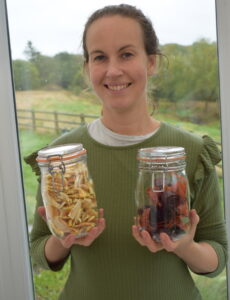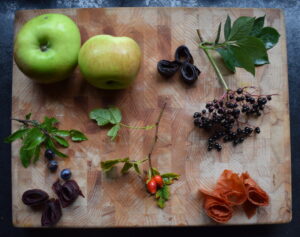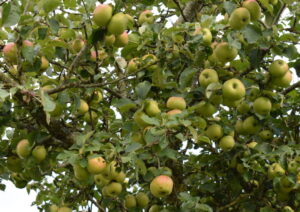30/09/22. Note: This is a guest post by Cathy.
We have apples coming out of our ears. There’s a beautiful Bramley apple tree here at our new place, with another non-cooking apple tree next to it.
Back in Hastings, if we had a surplus of anything, it was easy to find someone who wanted it. Here, we nearly got laughed out of a meet-the-neighbours group for even suggesting it; everyone else has too many apples too!
Dora has started school and they did a cooking lesson where she learned how to make a blackberry and apple crumble, so we’ve already made a few crumbles at home using her new-found skills.
Frozen apples
This week, I’ve started devoting some time to preserving some of the Bramleys for the longer term. Firstly, the obvious: freezing. You peel them, core them, cut them, toss them in lemon juice and spread them out on a baking sheet to ‘open freeze’ them. Then you transfer them to a bag. The advantage over putting them straight in the bag is that they don’t stick to each other, which makes it easier to defrost the right amount when you want to use them. So far 30 apples have met their demise this way.
Dried apples
 A further eight apples have been dried. Peel, core, thinly slice, then put them into a bowl of cold water with the juice of a lemon while you finish the rest. (I skipped the lemon for the second batch and can confirm, you need the lemon to stop them going brown.) Drain them and put them into the dehydrator, where they take a good eight hours or so to dry. You can also use a low oven.
A further eight apples have been dried. Peel, core, thinly slice, then put them into a bowl of cold water with the juice of a lemon while you finish the rest. (I skipped the lemon for the second batch and can confirm, you need the lemon to stop them going brown.) Drain them and put them into the dehydrator, where they take a good eight hours or so to dry. You can also use a low oven.
They’re sweet, sour and chewy, and the internet tells me they should last six months stored at room temperature.
Fruit leather
Twelve more apples have gone into chewy fruit leathers, and I’ve made three different flavours: (apple and) rosehip, elderberry and sloe.
The basic recipe is the same: peel, core and chop four apples (this makes two baking trays worth of leather), bring to the boil in a saucepan then simmer for 5-10 minutes until soft, then remove from the heat and drain off the water. Make sure you drain off the water before the apples disintegrate into mush (and I speak from experience here). Then put the lid back on for a few minutes to let them soften a bit more. Then add any other fruits you’re using, and a spoonful of sugar or two if you like.
In each case I used about two cupped handfuls of the ingredients below per four apples.
Sloes: Nice and easy – just simmer with a little water until soft, allow to cool, then pick out the stones.
Elderberries: Also easy, just remember it’s important to cook them because they are toxic raw. Remove all the green parts, add the berries to water, and simmer for 15 minutes. I also strained mine, but only to avoid lumpy leather.
Rosehips: It’s important to get rid of the seeds and irritating hairs from the insides. I did this by halving, scraping and rinsing, but I am a patient person! You can also cook them whole then strain them really well, though you get more wastage that way. Either way, simmer them in water for around 15 minutes.
 Blend your ingredients to a smooth paste. Line two baking trays with paper and spread out the paste to about 2-3mm, then dry in a low oven for 2-3 hours. To save energy, you can time it to coincide with dinner and use the top oven above whatever you’re cooking, or put the trays near/above a woodburner, in an airing cupboard, or in a sunny spot. Just make sure it’s a fly-free area.
Blend your ingredients to a smooth paste. Line two baking trays with paper and spread out the paste to about 2-3mm, then dry in a low oven for 2-3 hours. To save energy, you can time it to coincide with dinner and use the top oven above whatever you’re cooking, or put the trays near/above a woodburner, in an airing cupboard, or in a sunny spot. Just make sure it’s a fly-free area.
I’m expecting these to last around a month at room temperature, or much longer in the fridge (we previously made some that was still good at least six months later), and it can also be frozen.
What’s next?
Wine. Wine is next. I used to do a lot of wine making, but I haven’t done any since becoming a mum and not being able to devote areas of the house to bubbling glass containers. But now we have space, I’m going to dust off all the gear. Apparently Bramleys make a dry white, which sounds good to me and much more enticing than cider.
Also, there is a Latvian apple cake recipe in our family that I need to rediscover. It has a kind of meringue layer that rises to the top, which I remember being pretty amazing, if only I could find where I put the recipe.
Apple veterans, what do you do with yours?


Thank you, Cathy for those amazing ideas! We have a lovely elder tree and were wondering what we could do with the berries. So cooking makes them safe? Could I add them to a crumble?
I’m South African, and fruit leather (usually rolled up) is a staple snack for us! Especially guava – yum. Never thought about making my own! Happy experimenting
Yes, cooking makes them safe, and you could definitely put them in a crumble. Even the BBC agrees! https://www.bbcgoodfood.com/howto/guide/berry-bonanza
I’ve always loved fruit leather, though didn’t know it by that name until quite recently. Definitely what the health mums gave their kids in the 1980s!
I’d definitely have some apples 🙂
Are you in Ceredigion?
Yes in Gilfachreda – down the woods from you 🙂
In that case come and help yourself. I will email you our address.